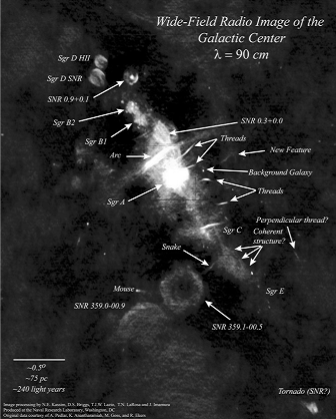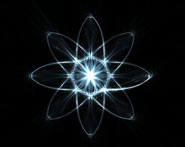


 الفيزياء الكلاسيكية
الفيزياء الكلاسيكية
 الكهربائية والمغناطيسية
الكهربائية والمغناطيسية
 علم البصريات
علم البصريات
 الفيزياء الحديثة
الفيزياء الحديثة
 النظرية النسبية
النظرية النسبية
 الفيزياء النووية
الفيزياء النووية
 فيزياء الحالة الصلبة
فيزياء الحالة الصلبة
 الليزر
الليزر
 علم الفلك
علم الفلك
 المجموعة الشمسية
المجموعة الشمسية
 الطاقة البديلة
الطاقة البديلة
 الفيزياء والعلوم الأخرى
الفيزياء والعلوم الأخرى
 مواضيع عامة في الفيزياء
مواضيع عامة في الفيزياء|
Read More
Date: 1-9-2020
Date: 25-2-2016
Date: 5-9-2020
|
The nuclear bulge or bar and the Central Molecular Zone
We have now reached the inner 500 pc of the Galaxy, the extended ‘Galactic Center’ (GC) region, which shows a number of characteristics that are distinctly different from any other part of the Milky Way. Observationally, investigation of the inner 500 pc (corresponding to a Galactic longitude of l = ±3.5o), at least close to the Galactic plane, is the domain of radio, millimetre and infrared astronomy, due to an extinction that does not allow observations at optical wavelengths. More recently, information on the GC region has been complemented by data from X-ray satellites.
Historically, the first maps of the inner 500 pc were obtained at long cm wavelengths in the radio continuum regime. Even at these long wavelengths, improvements are still possible, as has been impressively shown by the wide field radio image of the GC obtained at λ = 90 cm at the Very Large Array (VLA) presented by LaRosa et al (2000). At these wavelengths, the emission is mostly non-thermal, tracing supernova remnants, some of which are foreground objects, but H II regions and a large number of straight non-thermal filaments are also studied. Many of these filaments are located in the Galactic Center Radio Arc, a projected distance of 50 pc from Sgr A, which hosts the GC itself. The straightness of the filaments strongly suggests a direct relation to the magnetic field structure in the GC region.
The morphology of the ISM in the GC region is dominated by a number of H II regions, the most important of which are historically known as Sgr A, B2, C and D. The very presence of these H II regions shows that star formation in the GC region is ongoing. This conclusion is supported by the results on the age structure of the stellar population in the bulge mentioned earlier and the detection of young and massive star clusters. Not only does the Sgr A region, i.e. the ‘actual’ GC, host an unusual star cluster, there are at least two more such clusters, the Arches and the Quintuplet clusters (Cotera et al 1996, Figer et al 1999). These components of the GC region.
In the following, we will focus on the dense, molecular component of the ISMin the GC region. Giant molecular clouds are associated with the H II regions in the GC region. Surveys of the GC region in molecular lines show, however,

Figure 1.1. Full 330 MHz wide-field image of the Galactic Center at an angular resolution of approximately 45'' taken with the Very Large Array (LaRosa et al 2000). See also color section.
that molecular gas is very widespread in the GC region. The gas is traced by spectral lines in the mm range of the spectrum, most importantly the emission of 12CO and its isotopomers (12CO, Dame et al 2001; 13CO, Heiligman 1987; C18O, Dahmen et al 1997). Other useful molecules tracing gas at higher densities (n(H2) > 104 cm−3) are, e.g., HCN (Paglione et al 1998) or the shock tracer SiO (Martin-Pintado et al 1997).
Molecular emission is so widespread that we can speak of a continuous ‘Central Molecular Zone’ (CMZ) (Morris and Serabyn 1996). Its investigation requires surveys covering several square degrees using (preferentially southern) mm telescopes. These are, even today, large observational projects possibly taking years of observing time, since until very recently radio telescopes could only map a source by observing it point by point, a very time consuming process for a very extended region like the CMZ. A new generation of array receivers promises significant improvement, even though the number of ‘pixels’ so far is still typically <20. The large extent of the CMZ therefore explains the somewhat paradoxical situation that we tend to know more about the large-scale molecular content of nearby external galaxies in many molecules and transitions than in the CMZ. On the other hand, any observation of the CMZ, even with small telescopes, has better resolution than what can be achieved even with interferometers for external galaxies. Thus, the CMZ provides us with an important template for the study of external galaxies, and Galactic and extragalactic studies complement each other, a situation that is similar to the study of other constituents of the Milky Way.
The molecular layer of the Milky Way in general, including the CMZ and disk, is the coldest (10 K ≤ Tkin ≤ 100 K), thinnest (scale height <100 pc) and most dissipative component of the Galaxy. Thus, it is most susceptible to gravitational perturbations, caused either by a spiral arm or a bar. A survey of the entire plane of the Milky Way in 12CO (Dame et al 2001) shows, as expected, an almost 1 : 1 correspondence between the presence of molecular gas and dark (dust) clouds, i.e. regions of high extinction.
The gas in the CMZ is distinctly different from the molecular clouds found in the disk of the Milky Way: in the innermost Galaxy we find gas that is, on average, warmer and denser than in the disk, with temperatures reaching 100 K and more. In detail, the temperature structure of the CMZ gas is complex—non-LTE (LTE = local thermal equilibrium) radiative transfer models based on multi-line studies show that a large part of the dense component is cool (Tkin ∼ 20–30 K), while a ‘diffuse’, warmer component of much lower density is more widespread and may not be bound to molecular clouds (Huttemeister et al 1993, 1998, Dahmen et al 1998). Shocks play an important role and are traced by specific molecules like SiO as well as by H2 emission originating from a hot (for a molecular cloud, Tkin ∼ 600 K), possibly dense component, which, however, represents only a very small part of the total molecular mass in the CMZ (Rodriguez-Fernandez et al 2001).
This mass is not easy to estimate, since it has been shown from line intensity ratio analysis of different CO isotopomers that the Galactic ‘Standard Conversion Factor’ between 12CO 1 → 0 intensity and H2 column density (N(H2) ≈ 2×1020 ICO) systematically overestimates the gas mass if a warm, thin gas component is important. In this case, the 12CO emission is ‘overluminous’ compared to the Galactic disk conditions for which the conversion factor has been calibrated (Dahmen et al 1998). This result also applies to the central regions of external galaxies, even to Ultraluminous Infrared Galaxies (ULIRGs) which concentrate up to 109Mּ of molecular gas in their inner 500 pc.
Another aspect that makes the investigation of the CMZ (and also its neutral H I counterpart) worthwhile ties in with the determination of the three dimensional shape of the bulge. That the bulge can be seen as the outer part of the Galactic Center bar. Consequently, we expect to see clear evidence of the bar potential in the molecular and also neutral gas, since this is the most unstable component to gravitational perturbations.
Indeed, very convincing evidence for the barred morphology of the inner Galaxy has been found in studies of the kinematics of the gas. The evidence has accumulated over a decade, starting with work by Binney et al (1991). It played a very important role in establishing the Milky Way as a (weakly) barred galaxy, a property it shares with two-thirds of all spiral galaxies. The arguments rest on an examination of the longitude–velocity diagrams of both the CO and H I distribution in the inner 500 pc region. These diagrams show a characteristic ‘parallelogram’ structure that is not compatible with the gas clouds being on circular orbits around the Galactic Center. Strong emission is found at velocities that are ‘forbidden’ for circular motion, implying that the gas moves in a non-axisymmetric bar potential.
The parameters of this bar (φ and the corotation radius) had already been determined by Binney et al to be entirely consistent with what is found for the NIR structure of the bulge. Of course, the molecular bar is flatter than the bulge, since the gas is highly concentrated within the Galactic plane. The more sophisticated gas-dynamical simulations mentioned earlier (e.g. Fux 1999, Weiner and Sellwood 1999, Englmaier and Gerhard 1999) reproduce the detailed structure of the longitude–velocity diagram of the GC region, both for molecular and neutral atomic gas, in impressive detail in models taking into account the bar potential and gas-streaming motions along the bar.



|
|
|
|
لشعر لامع وكثيف وصحي.. وصفة تكشف "سرا آسيويا" قديما
|
|
|
|
|
|
|
كيفية الحفاظ على فرامل السيارة لضمان الأمان المثالي
|
|
|
|
|
|
|
شعبة مدارس الكفيل: مخيَّم بنات العقيدة يعزِّز القيم الدينية وينمِّي مهارات اتخاذ القرار لدى المتطوِّعات
|
|
|